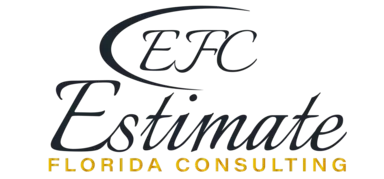Coral Gables’s construction costs are driven by high land prices ($100–$300/sq ft in prime areas, $40–$120/sq ft in suburbs), hurricane-resistant builds, and skilled labor shortages ($30–$45/hour). Coastal projects require premium materials like corrosion-resistant steel, while office developments demand smart tech and parking. Strict zoning and high demand for Class A spaces push costs to $200–$450/sq ft. Below is a detailed breakdown.
- Homepage
- Construction in Coral Gables
Office Construction in Coral Gables
Leading provider of office construction services.
Building an office in Coral Gables is a dynamic project that balances modern workspace demands with the city’s coastal climate, booming business scene, and premium real estate market. From small professional suites to towering corporate headquarters, construction costs are shaped by Coral Gables’s high land values, hurricane-resistant requirements, and need for energy-efficient, tech-savvy designs. At Estimate Florida Consulting, we provide precise, tailored estimates to guide your office project to success in this bustling metropolis. In this guide, we’ll explore office construction costs in Coral Gables, complete with detailed tables, an in-depth breakdown with construction specifics, and answers to common questions—ensuring you’re equipped to create a workspace that thrives.
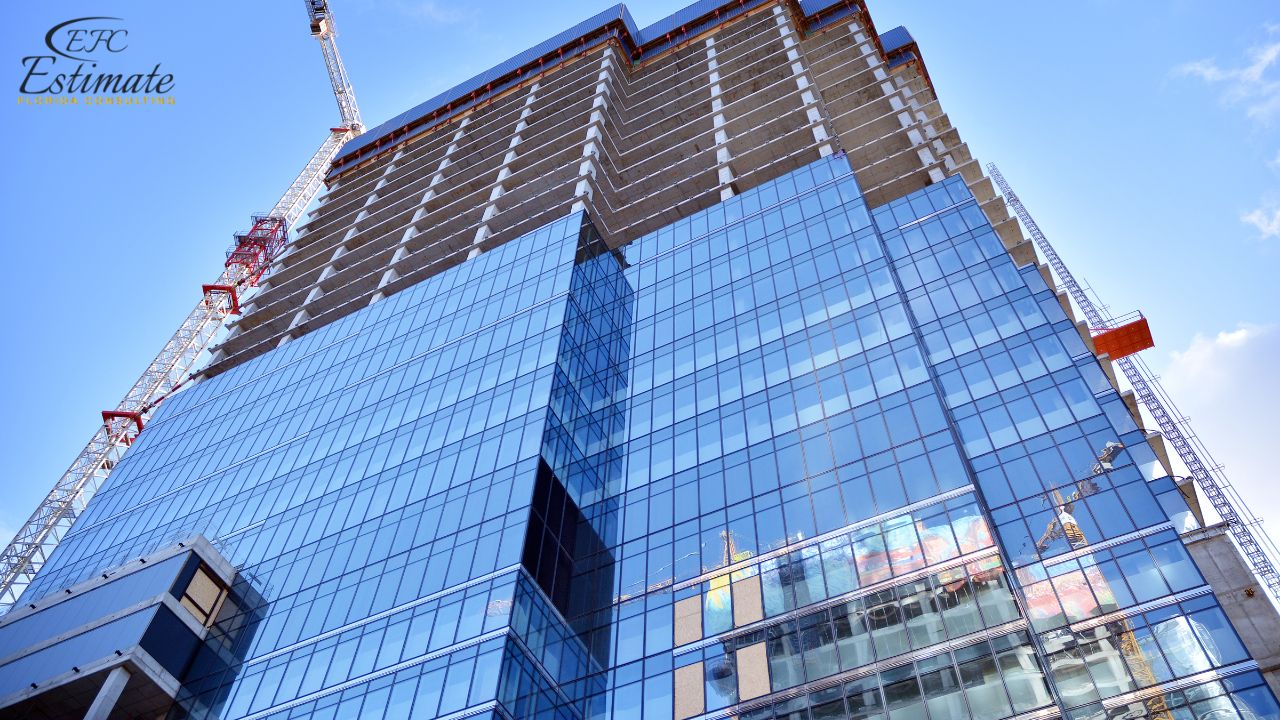
What Drives Office Construction Costs in Coral Gables?
Office Cost Construction in Coral Gables
Here’s a detailed table reflecting Coral Gables’s premium office construction market:
Office Type | Size (Square Feet) | Cost Range (Total) | Cost Per Sq Ft | Construction Timeline |
Small Office Suite | 5,000 – 15,000 | $1M – $3.5M | $200 – $250 | 8-12 months |
Mid-Size Office Building | 20,000 – 50,000 | $5M – $12.5M | $250 – $300 | 12-18 months |
Large Corporate Office | 60,000 – 100,000 | $18M – $35M | $300 – $400 | 18-30 months |
High-Rise Office Tower | 120,000 – 200,000 | $40M – $90M | $350 – $450 | 24-48+ months |
Office Construction Detailed Breakdown in Coral Gables
Coral Gables’s office construction market is dynamic, catering to businesses of all sizes, from startups to multinational corporations. The process typically includes planning, permitting, site preparation, structural work, and interior finishing, ensuring compliance with Florida’s building codes and energy efficiency standards. Costs vary based on location, materials, and design complexity, with premium office spaces in prime areas demanding high-end finishes, smart technology, and sustainable features. For small offices (5,000–20,000 sq. ft.), construction focuses on maximizing functionality, while mid-sized (20,000–100,000 sq. ft.) and large-scale projects (100,000–200,000+ sq. ft.) prioritize open layouts, collaboration spaces, and advanced infrastructure.
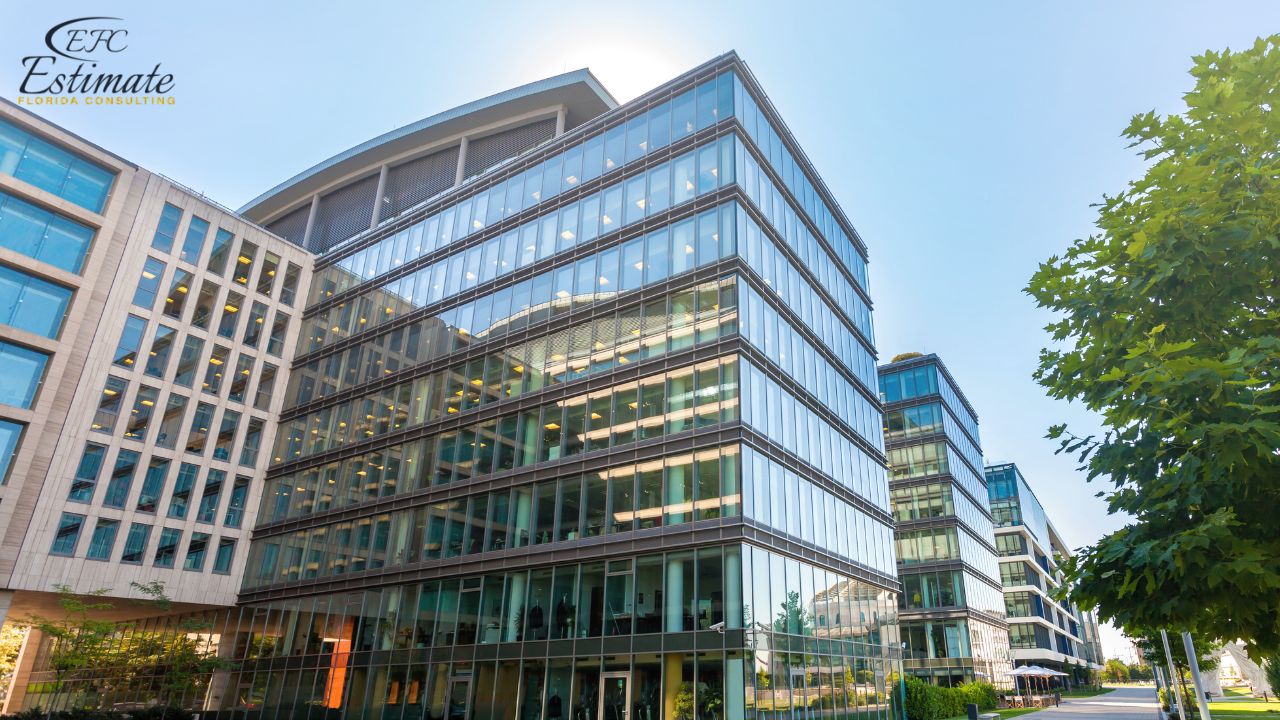
Factors like hurricane-resistant materials, LEED certifications, and modern amenities further impact costs, making detailed budgeting and expert planning crucial for successful office development in Coral Gables.
Size & Scope
- Square Footage: Small suites span 5,000 to 15,000 sq ft, while high-rise towers reach 120,000 to 200,000 sq ft, based on tenant needs and location.
- Total Cost Range: Small suites cost $1M – $3.5M, mid-size buildings $5M – $12.5M, and high-rises $40M – $90M, reflecting Coral Gables’s upscale rates and office demands.
- Examples: A 10,000 sq ft suite with 5 offices and a conference room, a 30,000 sq ft building with open workspaces, a 80,000 sq ft corporate office with 10 floors, or a 150,000 sq ft tower with a lobby and rooftop terrace.
Construction Phases & Costs
Site Preparation ($150K - $2M):
Small suites need basic clearing and grading ($150K – $300K), while large towers require excavation, soil stabilization, and stormwater systems ($1M – $2M) due to Coral Gables’s 60+ inches of annual rain. Drainage—swales or retention ponds—uses fill at $25 – $45 per cubic yard. Coastal sites may need wetland permits ($100K – $400K). Office prep includes parking lots and delivery zones.
90% More Chances to Win Projects With Our Estimate!
- Multi-Family Building
- Hotel Building
- Hospital Building
- Warehouse Building
- School & University Building
- High-Rise Building
- Shopping Complex
- Data Center Building
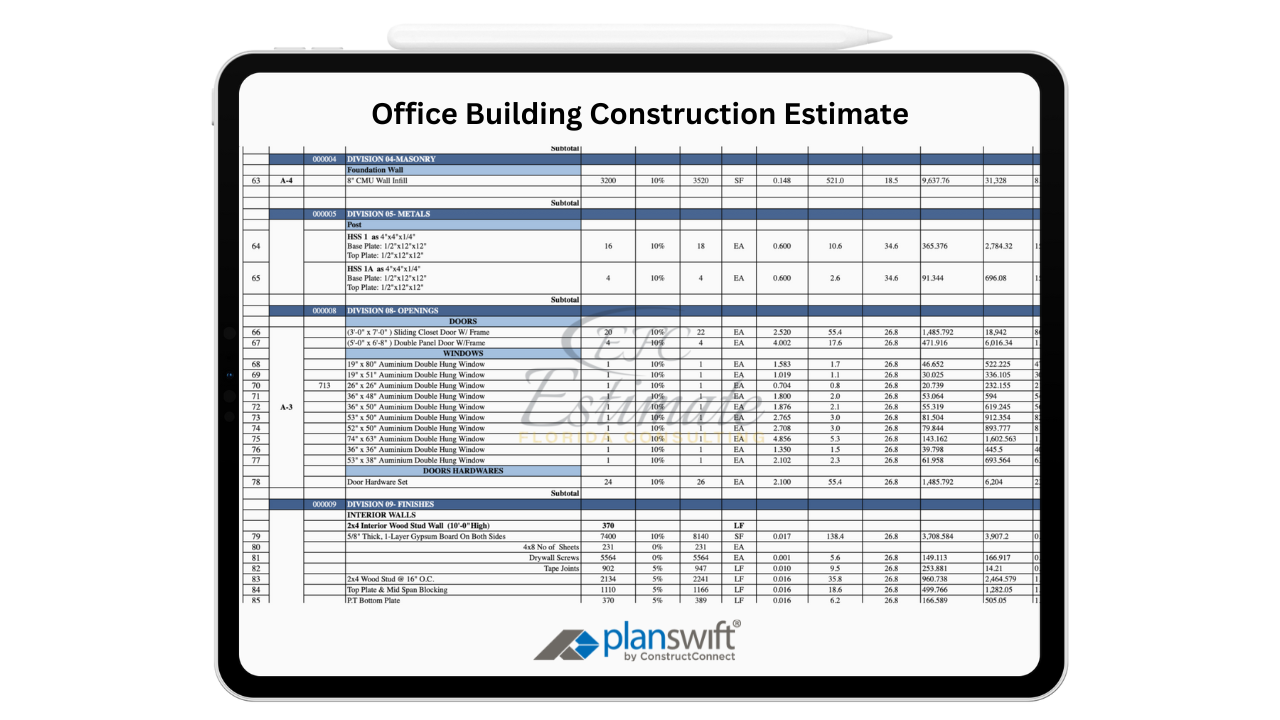
Foundation ($400K - $8M):
Small suites use shallow slabs ($400K – $800K), while high-rises need deep pilings (80-120 feet at $40 – $60 per linear foot) or mat foundations ($4M – $8M) to support multi-story loads and Coral Gables’s high water table. Flood-prone areas like Overtown require elevated bases.
Structure ($800K - $25M):
Small suites use steel frames with flat roofs ($800K – $1.5M), while high-rises employ wide-span steel with concrete cores and hurricane bracing ($12M – $25M). Exterior walls feature CMUs or glass curtain walls, and interiors include acoustic panels for meeting rooms. Structures meet 175 mph wind codes.
Interior Finishes ($300K - $7M):
Small suites use carpet and basic fixtures ($300K – $600K), while large offices add hardwood, smart lighting, and tenant-specific fit-outs ($4M – $7M). Open-plan designs and soundproofing are standard.
Infrastructure ($500K - $10M):
Infrastructure costs in Coral Gables office construction vary significantly based on building size and complexity. Small office suites (5,000–20,000 sq. ft.) require efficient HVAC systems, basic electrical wiring, and reliable internet connectivity, typically ranging from $500K to $1M. Mid-sized offices (20,000–100,000 sq. ft.) demand upgraded power distribution, enhanced networking capabilities, and advanced security systems, increasing costs. High-rise offices (100,000–200,000+ sq. ft.) require high-capacity electrical systems, fiber-optic cabling, emergency backup generators, and advanced HVAC solutions with air purification, costing $6M to $10M. Energy efficiency is a priority, with solar shading, smart lighting, and eco-friendly insulation helping to reduce operational costs.
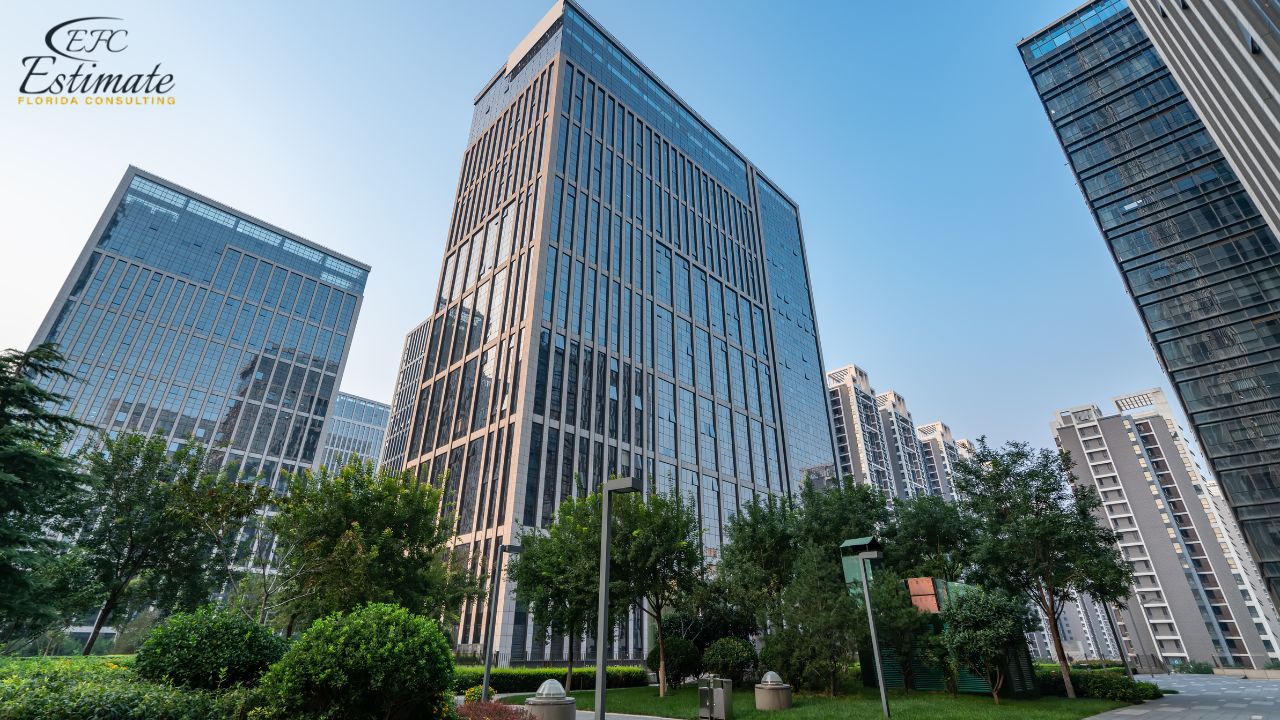
Additionally, Coral Gables’s strict building codes mandate hurricane-resistant infrastructure, impacting design and material choices for long-term resilience.
Amenities ($200K - $12M):
Small suites include break rooms and 50 parking spaces ($200K – $500K), while high-rises add lobbies, rooftop terraces, and multi-level garages ($8M – $12M). Security systems and green spaces enhance appeal.
Soft Costs ($250K - $5M):
Small suites need basic permits and design ($250K – $600K), while large projects require detailed engineering, zoning approvals, and environmental reviews ($3M – $5M). Traffic studies add $30K – $500K.
Coral Gables-Specific Details
- Hurricane Prep: Impact windows and roof tie-downs add $100K – $4M, with large offices featuring storm-resistant power backups per 185 mph gust standards (2025 codes).
- Cooling Systems: HVAC with humidity control costs $400K – $5M, addressing Coral Gables’s 70-90% humidity.
- Sustainability: Energy-efficient designs (e.g., LED lighting) add $200K – $1M, appealing to eco-conscious tenants.
- Timeline: Small suites take 8-12 months, high-rises 24-48+ months, with rain (June-November) or permitting delays in areas like Coral Gables.
- Tenant Flexibility: In Coral Gables’s fast-evolving market, offices often incorporate modular walls and adaptable layouts, costing an extra $50K – $500K depending on size. This flexibility suits tech startups in Wynwood, law firms in Brickell, or hybrid-work firms needing reconfigurable spaces. Larger projects may also include multi-tenant designs with shared amenities like coworking lounges, adding $300K – $1M to cater to Coral Gables’s diverse business ecosystem.
Example Projects
- Small: A 10,000 sq ft suite with 5 offices and 40 parking spaces costs $2M – $2.5M (10 months).
- Large: A 150,000 sq ft high-rise with 12 floors and a rooftop terrace costs $50M – $65M (36 months).
3D Rendering Cost for an Office Building in Coral Gables
3D rendering costs for offices in Coral Gables vary by complexity. Basic exterior visuals range from $600 – $1,800, while detailed renders with interiors and office layouts cost $2,500 – $10,000. Animations or VR tours can exceed $15,000. Professional rendering ensures accurate design representation.
Call Us Now!
We Provide 3D Rendering Services!
For Office Buildings and Other Projects
Turnaround time is 1-2 days.
Win More Projects With Us
Coral Gables-Specific Considerations for Office Building Construction
Coral Gables’ distinctive setting poses unique challenges that affect office building construction planning and costs.
- Hurricane Preparedness – Office buildings require reinforced structures, impact-resistant windows, and stormproof designs to endure hurricanes, increasing construction costs by 10-20%.
- Flood Zones – Low-lying areas demand elevated foundations, advanced drainage, and waterproofing to combat flooding risks, particularly during heavy rains.
- Permitting Challenges – Coral Gables enforces stringent zoning, historic preservation codes, and aesthetic standards (e.g., Mediterranean Revival style), potentially lengthening timelines and raising expenses.
- Labor Availability – High demand for skilled workers in South Florida can elevate labor costs and delay project completion.
Proper planning, collaboration with local officials, and compliance with safety, environmental, and architectural guidelines are critical for constructing durable and compliant office buildings in Coral Gables.
Sustainable Office Building Construction Trends in Coral Gables
Sustainability is increasingly central to office building construction in Coral Gables.
- Energy Efficiency – LED lighting, solar panels, and high-efficiency HVAC systems cut operational costs, boosting energy savings and reducing utility expenses for tenants.
- Green Materials – Recycled steel, low-VOC paints, and insulated concrete enhance durability, lower environmental impact, and improve indoor air quality.
- Water Management – Rainwater harvesting, permeable paving, and water-efficient fixtures address Coral Gables’ rainfall patterns, minimizing waste and promoting sustainable water use.
These eco-friendly features can raise initial costs by 5-15%, but they deliver long-term savings, better work environments, higher property values, and potential tax benefits, aligning with Coral Gables’ focus on environmental stewardship.
Construction Timeline Expectations for Office Buildings in Coral Gables
Understanding timelines is key for planning and budgeting office building projects in Coral Gables:
- Small Office Buildings (Up to 20,000 sq. ft.) – Typically 8-14 months, depending on design and site specifics.
- Mid-Size Office Buildings (20,000-50,000 sq. ft.) – 14-24 months, including permitting, site work, and local requirements.
- Large Office Buildings (>50,000 sq. ft.) – 24-36+ months, especially with complex designs, premium features, and hurricane-proofing.
Coral Gables-Specific Factors: Strict zoning, historic preservation rules, hurricane-resistant construction, and flood mitigation can add 3-6 months. Early collaboration with contractors, architects, and local officials ensures smooth progress and adherence to regulations.
90% More Chances to Win Office Buildings Bids with Our Estimate
Additional Construction Details in Coral Gables
Material Choices
- Concrete: Precast or poured-in-place ($160 – $220 per cubic yard) for durability.
- Steel: Galvanized ($1,600 – $2,200 per ton) resists coastal corrosion.
- Roofing: Metal or TPO systems ($12 – $20 per sq ft) for heat and storm resistance.
Design Considerations
- Orientation: Workspaces face north to reduce glare and cooling costs.
- Ventilation: High-efficiency systems cut energy use by 10-20%.
- Tech Integration: Smart wiring and IoT-ready designs meet modern office needs.
Land Acquisition Costs
Land acquisition costs in Coral Gables vary significantly based on location. In urban Coral Gables, prices range from $100 to $300 per square foot, making a 100,000-square-foot property cost between $10 million and $30 million. These high costs are driven by demand, limited space, and prime real estate value. Suburban areas, on the other hand, offer more affordability, with prices ranging from $40 to $120 per square foot. This makes them ideal for larger developments, such as commercial complexes, industrial facilities, or residential communities. The lower land costs in suburban areas provide greater flexibility for developers looking to maximize space while maintaining cost efficiency.
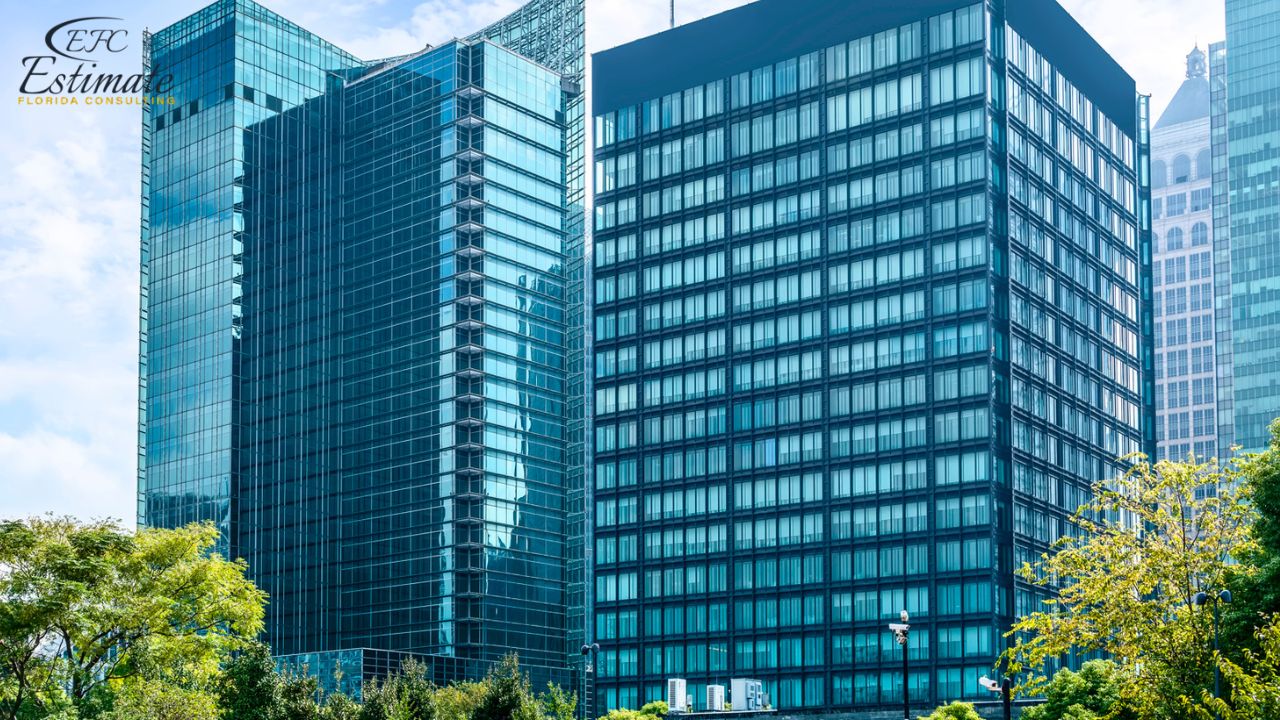
Contingency & Extras
- Buffer: 15-20% ($150K – $18M) for delays or material spikes (e.g., steel up 20% in 2025).
- Premium Features: Green roofs or fitness centers add $2M – $8M.
Role of Professionals for Office Building Construction in Coral Gables
- Contractors: Oversee the entire office building construction project, ensuring quality work, managing materials, labor, and timelines while adhering to safety regulations. Hire experienced contractors to keep your project on track.
- Subcontractors: Specialize in critical tasks such as electrical systems, plumbing, HVAC installation, and structural work to ensure durability and efficiency. Hire skilled subcontractors for high-quality execution.
- Architects: Design innovative, functional, and energy-efficient Office layouts that meet safety codes and enhance learning environments. Hire professional architects to create the perfect office building design.
- Engineers: Ensure the structural integrity, safety, and efficiency of the office building by planning and overseeing mechanical, electrical, and civil aspects. Hire expert engineers to guarantee a strong and sustainable structure.
- Construction Estimators: Provide accurate cost assessments for materials, labor, and project timelines to help optimize budget planning and prevent cost overruns. Hire professional estimators to ensure financial efficiency and project feasibility.
Get 5 New Projects in the Next 7 Days With Our System
Why Partner with Estimate Florida Consulting for Office Construction in Coral Gables?
At Estimate Florida Consulting, we excel in Coral Gables’s office construction challenges with:
- Accurate estimates tailored to your project and Coral Gables’s market.
- Expertise in hurricane codes, zoning laws, and sustainability trends.
- Consultations—call 561-530-2845 to start today.
Conclusion
Office construction in Coral Gables ranges from $1M for a small suite to $90M for a high-rise tower, driven by land costs, materials, and local demands. With careful planning, you can build a modern, resilient workspace. Contact Estimate Florida Consulting for a custom estimate and let’s shape Coral Gables’s business future!
Question Answer
Frequently Asked Question
An office building is a commercial structure designed for business operations, providing workspaces, meeting rooms, and essential amenities. It supports productivity, collaboration, and professional activities, varying in size, design, and classification based on quality and location.
Building your own office requires careful planning and execution. Here are the key steps:
- Define Requirements – Determine the size, layout, and features based on your business needs and budget.
- Secure a Location – Choose a suitable site considering accessibility, zoning laws, and future growth potential.
- Design & Planning – Work with architects and engineers to create a functional and efficient design.
- Obtain Permits – Secure necessary approvals and permits from local authorities.
- Hire Contractors – Select experienced builders and subcontractors for construction.
- Construction & Quality Control – Oversee the building process, ensuring quality materials and adherence to safety regulations.
- Install Utilities & Interiors – Set up electrical, plumbing, HVAC systems, and furnish the space as per business needs.
- Final Inspection & Occupancy – Conduct inspections to ensure compliance, obtain occupancy certificates, and move in.
Proper planning, budgeting, and professional assistance are essential for a successful office building project.
The structure of an office refers to its physical layout and organizational framework, designed to enhance productivity and workflow. It typically includes:
- Reception Area – The first point of contact for visitors and clients.
- Workspaces – Individual or shared desks, cubicles, or open-plan seating for employees.
- Meeting Rooms – Spaces for team discussions, client meetings, and presentations.
- Executive Offices – Private offices for management and senior staff.
- Break Rooms & Cafeteria – Areas for employees to relax and have meals.
- Conference Rooms – Larger rooms equipped with technology for important meetings and presentations.
- Storage & Filing Areas – Dedicated spaces for document storage and office supplies.
- Restrooms & Utility Rooms – Essential facilities for hygiene and maintenance.
- IT & Server Rooms – Spaces for networking equipment, servers, and technical infrastructure.
- Parking & Outdoor Areas – Parking spaces, landscaping, and outdoor seating if applicable.
The structure varies depending on business needs, office size, and design preferences.
Owning an office building can be profitable, but it depends on various factors, including location, market demand, and management. Here are the key aspects that contribute to profitability:
- Rental Income – Renting out office space to businesses can provide a steady cash flow. Prime locations and high-quality buildings typically attract higher rents.
- Property Appreciation – Over time, the value of the building may increase, offering a potential for capital gains if you decide to sell.
- Tax Benefits – Property owners can take advantage of tax deductions related to depreciation, maintenance, and operating expenses.
- Diversification – Office building ownership can diversify an investment portfolio, especially for long-term investors.
However, profitability also comes with risks such as market fluctuations, tenant turnover, maintenance costs, and the need for proper property management. Strategic location, effective leasing, and regular maintenance are critical to maximizing profitability.
The layout of an office refers to the arrangement of spaces within the building to maximize efficiency, productivity, and employee satisfaction. It includes:
- Open Office Space – Large, open areas with desks or workstations for employees, promoting collaboration and communication.
- Private Offices – Enclosed spaces for executives, managers, or team leaders, providing privacy for focused work.
- Meeting Rooms – Spaces for discussions, presentations, and team meetings, often equipped with multimedia tools.
- Break Rooms & Cafeterias – Relaxation areas where employees can take breaks, eat, and socialize.
- Reception Area – The front desk or lobby area where visitors and clients are greeted.
- Storage & Filing Areas – Designated spaces for storing documents, office supplies, and equipment.
- Restrooms – Essential facilities located strategically throughout the office.
- Conference Rooms – Larger rooms designed for group meetings, with ample seating and tech for presentations.
- IT & Server Rooms – Dedicated spaces for technology infrastructure and network equipment.
The layout can be customized based on company culture, the type of work being done, and space requirements. Popular modern layouts include open-plan offices, flexible workspaces, and collaborative zones.
The time it takes to build a small office building typically ranges from 6 months to 1 year. The exact duration depends on various factors, including:
- Design & Planning – This phase can take a few weeks to a few months, depending on the complexity of the design and approvals required.
- Permits & Approvals – Securing necessary building permits and zoning approvals can take time, ranging from a few weeks to several months.
- Construction Phase – Building the structure itself can take anywhere from 4 to 8 months for a small office building, depending on the size, materials, and weather conditions.
- Finishing & Interior Work – Installing utilities, interior furnishings, and final touches can add another 1 to 2 months.
Overall, while smaller projects can move quickly, delays in permitting, design changes, and contractor availability may extend the timeline. Proper planning and hiring experienced professionals can help streamline the process.
Looking For
Construction Professionals For Your Project?
- Electrical
- Plumbing
- Masonry
- Roofing
- Painting
- More

